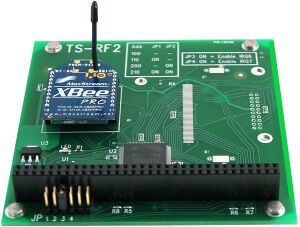TS-RF2-ZIGBEE
 | |
| Product Page | |
| Documents | |
|---|---|
| Schematic |
Download required software
You will first need to obtain the TS-UART loader:
https://files.embeddedTS.com/old/rf2/
You will need to compile the tsuart-rf.c kernel module, or else download the pre-compiled module (if available).
Installing the driver
Next install the module in the appropriate location for your distribution. Typically this will involve copying the .o files the somewhere in the /lib/modules directory, and possibly running a utility such as depmod to bring your module list up to date. Please consult the documentation for the distribution you are using for further information.
Note: If all else fails, you can always run the following command in the directory the module is stored in:
insmod ./tsuart-rf.o
| Note: | The tsuart0.o module must be loaded before the above loader module can successfully run. If you are using a module dependency program such as modprobe these dependencies should be resolved for you automatically. |
Communicating wirelessly using the XBEE device
Once loaded, a new TS-UART device file will appear in /dev. The exact name of this file will depend on the the number of TS-UARTs already loaded on your system, but the name of the driver will be of the form:
ttyTSx
where x is an integer denoting the order in which the driver was loaded.
Communication with the Digi device defaults to transparent serial mode. If you have two units operational with a terminal emulation program running on both unit you should be able to verify operation by pointing both programs to use the appropriate ttyTS entry, and then typing on either side. Please consult the XBEE documentation for more information on Maxstream specific features which can be invoked using AT commands.
IO Selection
| JP1 | JP2 | Address |
|---|---|---|
| Off | Off | 0x100 |
| Off | On | 0x200 |
| On | Off | 0x110 |
| On | On | 0x210 |
IRQ Selection
| JP3 | JP4 | PC104 IRQ |
|---|---|---|
| Off | Off | N/A (Will not work) |
| Off | On | 7 |
| On | Off | 6 |
| On | On | 7 (shared) |
Usage with 3rd party devices
Please note that while efforts are made to follow the PC/104 specification this peripheral is not tested with third party SBCs or connected peripherals. This card is not guaranteed to operate as intended when third party PC104 peripherals or SBCs are connected.